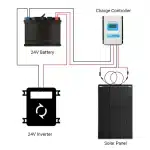Table of Contents
- What are BTUs and Watts?
- Comparison of British Thermal Units BTUs and Watts
- BTU to watts conversion
- Applications of BTUs and Watts in Different Sectors
- How does the BTU to watt conversion help us in our daily lives?
- In summary: BTU to watts
- BTU to watts Frequently Asked Questions
Understanding BTU to watts conversion is not just for physics enthusiasts, converting BTU/hr to watts is essential for anyone who wants to optimize their energy consumption.
This guide will demystify BTUs (British Thermal Units) and watts, provide easy-to-understand formulas and calculations, and look at real-world examples of how to apply this knowledge in everyday life.
Ready to improve your energy intelligence? Let’s get started!
What are BTUs and Watts?
British thermal unit per hour
Definition: The British thermal unit per hour (symbol: BTU/h) is a unit of power commonly used in the United States. It is often abbreviated as “BTU”, which is the same abbreviation as the British Thermal Unit (a unit of heat measurement).
One watt (a power unit derived from the International System of Units) equals approximately 3.41214 BTU/h.
History/Origin: The British Thermal Unit per hour is based on the British Thermal Unit (Symbol: Btu or BTU), which is the traditional American unit of heat, which is a type of energy transfer, where energy is transferred from a hotter substance to a cooler substance.
A BTU is specifically defined as the amount of heat required to raise the temperature of one pound of water by one degree Fahrenheit. It has many different definitions, but all are equivalent to about 1,055 joules.
Current Use: When you fire up your gas grill, for example, it may put out 40,000 BTUs, effectively heating your grill to a searing temperature suitable for summer barbecues. BTU/hour is not a widely used unit.
Multiples of watt-hours (usually kilowatt-hours) are more commonly used than BTUs/hour, even in the United States.
Watt
Definition: The watt (symbol: W) is a derived unit of power from the SI (International System of Units). It is defined as 1 joule per second and is used to quantify the rate of energy transfer.
History/Origin: Named after the Scottish inventor James Watt, the concept was first introduced in 1882 by William Siemens, who defined it as “the power transmitted by an ampere of electric current through a potential difference in volts”. This was the definition used in the existing system of units at the time.
In 1908, the “International” definition was introduced and Siemens’ definition was adopted as the International Watt. These definitions remained in use until 1948, when the International Conference on Weights and Measures redefined the watt as an absolute unit, using only mass, time, and length.
1 Absolute Watt equals 1.00019 International Watts. 1960 saw the adoption of the Absolute Watt as the SI unit of power.
Current Use: As a derivative of the International System of Units for power, the watt, and all its multiples and fractional multiples, are used worldwide in many fields, from radio transmission to the power industry.
The watt as a unit of power should not be confused with its energy counterpart, the watt-hour (and all its multiples/fractional multiples).
For example, a standard LED light bulb may use about 10 watts of power, much less than a traditional 60-watt incandescent bulb, demonstrating a leap in energy efficiency.
Understanding these units can help make informed energy use decisions in everyday life, from choosing the right appliances to managing your home energy budget smartly.
Comparison of British Thermal Units BTUs and Watts
The table below shows the key differences between BTUs and watts, two important units of energy measurement. It highlights how each unit is used, how BTUs and watts are used in HVAC systems and equipment, and their overall importance in managing energy consumption.
| Aspect | BTUs (British Thermal Units) | Watts |
| Type of Energy | Thermal energy | Electrical power |
| Measurement | Indicates how much heat is produced or absorbed | Indicates how much electricity is used or generated |
| Usage in HVAC Systems | Commonly used to measure the heating capacity | Commonly used to measure the power consumption |
| Example in HVAC Systems | Electric heater’s heating capacity listed in BTUs | Electric heater’s power consumption listed in watts |
| Practical Application: Appliances | Useful for measuring and managing energy consumption in heating and cooling | Crucial for estimating electricity consumption and managing energy costs |
| Overall Importance | Focuses on thermal energy for heating and cooling needs | Measures electric power for managing energy consumption |
BTU to watts conversion
Convert BTU (IT)/hour to watts. This is a convert BTU to watts calculator/watts to BTU calculator, please provide the following values to convert BTU/hr to watts. Understanding Converters.
BTU/hr to watts conversion table
| BTU (IT)/hour [BTU/h] | Watt [W] |
| 0.01 BTU/h | 0.0029307107 W |
| 0.1 BTU/h | 0.029307107 W |
| 1 BTU/h | 0.2930710702 W |
| 2 BTU/h | 0.5861421403 W |
| 3 BTU/h | 0.8792132105 W |
| 5 BTU/h | 1.4653553509 W |
| 10 BTU/h | 2.9307107017 W |
| 20 BTU/h | 5.8614214034 W |
| 50 BTU/h | 14.6535535086 W |
| 100 BTU/h | 29.3071070172 W |
| 1000 BTU/h | 293.0710701722 W |
Conversion of BTU to watts/watt to BTU conversion: conversion formulas and practical applications
Understanding the conversion of BTU and watts/watt to BTU/hr, in addition to the conversion table above, provides an understanding of the core conversion formulas and calculations that link these two key energy measurement units.
Converting BTUs to Watts
To convert BTU to watts, you can use a simple formula: watts = BTU x 0.293
For example, if your air conditioner is rated at 12,000 BTUs, multiply 12,000 by 0.293 to get the watts equivalent: 12,000 BTUs x 0.293 = 3,516 watts
Multiplying watts to BTU/hr
It’s also important to do it the other way around. To convert watts to BTUs, use the following formula: BTU = watts x 3.41
So, if an appliance draws 600 watts, its BTU power is calculated as follows: 600 watts x 3.41 = 2,046 BTUs
Converting kilowatts to watts
Sometimes you need to convert kilowatts (kW) to watts (W). This is easy because 1 kilowatt equals 1,000 watts: Watt = kW x 1,000
For example, 3 kilowatts is: 3 kilowatts x 1,000 = 3,000 watts. There is also How To Convert Watts To Amps that you can learn.
Practical Example
Suppose you have a heater rated at 5,000 watts. To find its equivalent in BTUs and kWs, you can use the above formula:
1. Convert watts to BTUs: 5,000 watts x 3.41 = 17,050 BTUs
2. Converting Watts to Kilowatts: 5,000 Watts ÷ 1,000 = 5 Kilowatts
By understanding and applying these conversions, you can better manage and compare the energy consumption of different systems and appliances. This knowledge is essential for optimizing energy use and improving energy efficiency in both domestic and commercial environments.
Applications of BTUs and Watts in Different Sectors
Use of BTUs in air conditioning and heating systems
BTUs and watts are both critical units in heating, ventilation, and air conditioning (HVAC) systems.BTUs (British Thermal Units) are used to measure the cooling and heating capacity of air conditioning and heating systems. Putting BTUs to watts can significantly improve the energy efficiency assessment of your home or business.
When evaluating an air conditioning unit or portable solar panels, understanding watts to BTU hour conversion/BTU to watt conversion can help determine the amount of energy consumed by the equipment versus the amount needed to cool the space efficiently.
This is critical to ensure that you are not overusing energy, thereby reducing waste and utility bills.
For example, an air conditioner with a cooling capacity of 10,000 BTU/h means it can remove 10,000 BTUs of heat from a room per hour.
Heating Equipment: The heating capacity of gas furnaces and heat pumps is also expressed in BTUs. For example, a gas furnace may have a heating capacity of 80,000 BTU/h.
Watts to measure the power requirements of appliances
A watt is the standard unit of measurement for the power demand of an appliance. For example, an air conditioner has a power consumption of 2,930 watts (based on its cooling capacity of 10,000 BTU/h), which means that the appliance consumes 2,930 watts of electricity per hour when running.
Electric heaters: For example, an electric heater may have a power of 1,500 watts, which means it consumes 1,500 watts of electricity per hour when operating.
How does the BTU to watt conversion help us in our daily lives?
Planning and implementing energy-saving measures
When planning energy-saving measures, such as installing solar panels, the conversion between BTUs and watts provides a quantitative basis for estimating potential savings.
For example, if solar panels output a specific number of watts, converting them to BTUs can help homeowners understand how much heat they can offset. This is especially useful in temperate climates, where heating needs can create significant energy bills.
Combined with advanced solar solutions, such as Sungold 400W solar panels, energy efficiency in a residential environment can be significantly improved.
Improving Energy Efficiency
Energy Efficiency Ratio (EER) and Seasonal Energy Efficiency Ratio (SEER) are important measures of HVAC system efficiency:
- EER (Energy Efficiency Ratio): EER = Cooling Capacity (BTU/h) / Power Consumption (Watts), which represents the amount of cooling per unit of electricity consumed.
- SEER (Seasonal Energy Efficiency Ratio): SEER is the average cooling efficiency measured under different seasonal conditions, reflecting the average efficiency of the system in operation throughout the year.
Utilizing the knowledge of BTUs and Watts, the following strategies can be used to improve energy efficiency:
- Choose high-efficiency equipment: Select equipment with higher EER and SEER.
- Regular maintenance: Maintain regular maintenance of equipment to ensure its efficient operation.
- Optimize use: Use equipment wisely based on demand to avoid unnecessary energy waste.
Troubleshooting Home Appliances and Systems
For homeowners, understanding the BTU to watt conversion is an important tool for troubleshooting and maintaining appliances and systems. By knowing the energy output in watts, you can assess whether the heating elements in an appliance are working properly or if a unit is consuming too much power.
This knowledge allows consumers to make necessary adjustments or seek professional help before inefficiencies lead to increased costs or system failure.
In summary: BTU to watts
Understanding BTU to watts conversion/watt to BTU conversion is critical to effectively managing energy use in everyday life. It enables us to assess energy efficiency, accurately design HVAC systems, and implement energy-saving measures.
This knowledge also helps troubleshoot household appliances and develops environmental awareness. By mastering convert BTU/hr to watts, we can make informed decisions that benefit both our wallets and the environment.
BTU to watts Frequently Asked Questions
Let’s explore some frequently asked questions to gain insight into BTU to watts.
What is the significance of converting BTU to watts?
Converting BTUs to watts is important for comparing the heating and cooling capacities of different systems because watts are the standard unit of power in the International System of Units (SI).
How do I find the British Thermal Units (BTUs) for an air conditioner?
To find the BTU rating of an air conditioning unit, check to see if the model number is an even, two-digit number between 18 and 60, or a three-digit number that begins with a zero.
For example, 018 means 18,000 BTUs, 024 means 24,000 BTUs, and 030 corresponds to 30,000 BTUs. Once you’ve found it, let’s calculate its energy conversion value.
Essential Solar Panel Electrical Knowledge:
Milliamps to Amps | Solar Panels Series vs Parallel | Volts to Watts | kWh to Amps | BTU to Watts










